5. Hellboy (2004)
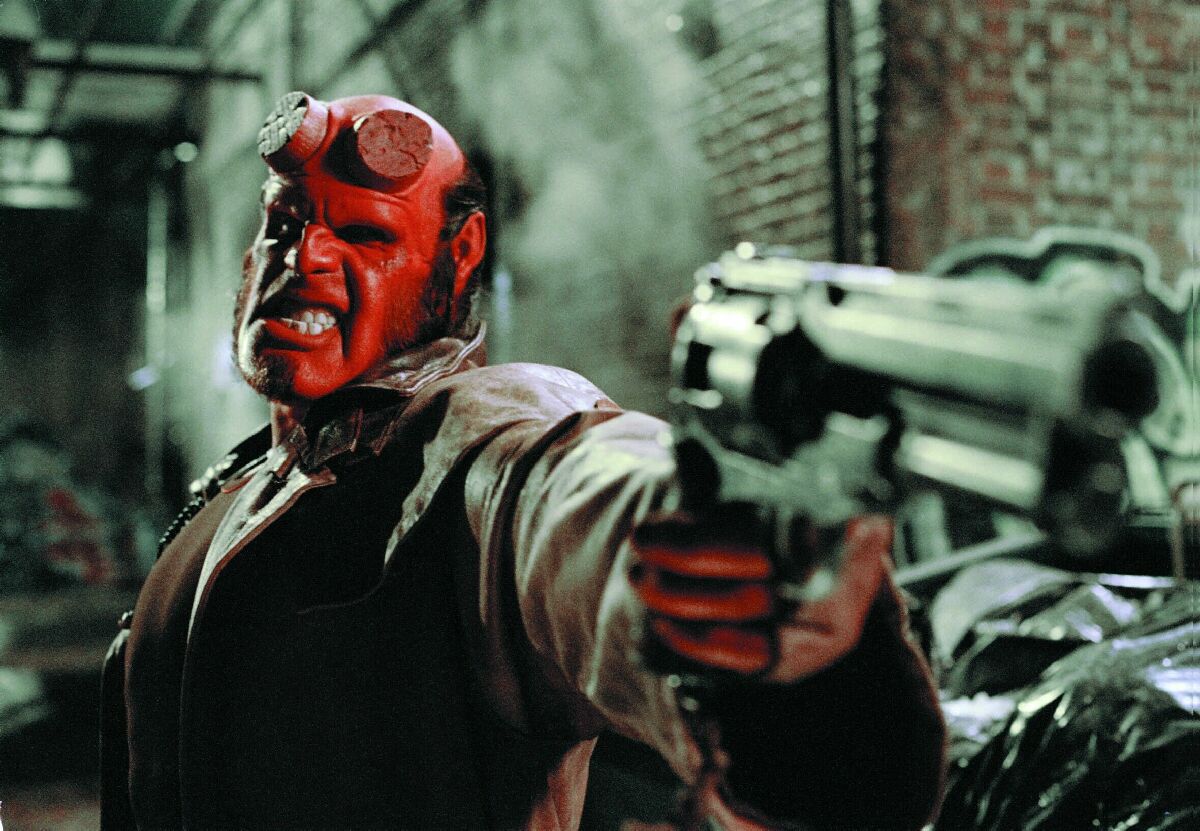
“’What makes a man a man?’ a friend of mine once wondered. Is it his origins? The way he comes to life? I don’t think so. It’s the choices he makes. Not how he starts things, but how he decides to end them.”
-Ruperth Evans’ John Myers in Hellboy
Compared to the nearly saturated string of superhero films that sprung in the last decade, there is a notable vibrant energy as well as emotional balance in del Toro’s Hellboy that casts an impression similar to that of reading a comic-book. Loosely based on Mike Mignola’s graphic novel Hellboy: Seed of Destruction, del Toro calibrates the comic stripped catchphrases, straightforward smackdowns, practical effects, production design, and character portrayals in a manner that neither falls in corny comedy routines or bleak CGI artificiality, but allows Hellboy to unfold in both a lighthearted and authentic pace.
“What is it that makes man a man?” asks John Hurt’s supernatural expert Trevor Broom during the film’s prologue, which features an engaging action-packed WWII setpiece that concludes with the eponymous hero’s introduction as a small red-imp with horns, pointed tail, and an arm made of stone. In the present day, under Dr. Broom’s strict care, Hellboy (Ron Pearlman born for the role) has grown into a muscular, too self-conscious loner, who loves smoking cigars as much as he adores kittens.
Part of the Bureau of Paranormal Research and Defense (BPRD) – a secret intelligence organization tasked with protecting the country from the occult and supernatural – comprised by an elite team of trained agents, his knowledgeable adoptive father, the courteous amphibian humanoid Abe Sapien (del Toro go-to nonhuman role actor Doug Jones), and the well-meaning young rookie John Myers (Rupert Evans), Hellboy operates as the agency’s main muscle, who only enters the outside world when granted access, to fight monsters and other evil forces, but occasionally escapes to visit his love interest in a mental hospital, the pyro-telekinetic Liz (Selma Blair).
However, when shadows from the past resurface in the form of Grigori Rasputin (Karel Roden; and yes, based on the real life Russian mystic), and his two faithful subordinates: a dual katar-like dagger wielding immortal assassin (Ladislav Beran) and Rasputin’s cruel partner, Ilsa Haupstein (Bridget Hodson), Hellboy is forced to grow into the mantle of hero if he hopes to stop an insurrection from a multiplying Cthulhuian creature by the name of Sammael (Bryan Steele).
In terms of performances, Pearlman in not only brilliantly cast as the larger than life demon hero, but he brings enthusiasm and vulnerability to the character that viewers immediately find endearing. Opposite to Pearlman’s charisma, Blair is captivating as the nuanced Lis, who maintains a fragile and waning presence throughout film.
In many ways, del Toro’s superhero dark fantasy is visually reminiscent of Men in Black (I & II) and sci-fi horror Mimic. Although this is largely attributed to the film’s brilliant make-up artist, Rick Baker (Men in Black; An American Werewolf in London) and his bizarre (opposed to just horrific) designs, it also stems from del Toro’s discernment over when and for what use practical effects rather than CGI and vice versa. The action sequences unfold like fist slugfests whose practical effects – Hellboy being tossed, the subway’s vandalism, exploding monsters – are as downright outrageous as they are hilarious.
Despite few transitional stumbles, a combined effort between del Toro’s tonal consistency and Pearlman’s superb performance in the central role, establish Hellboy as a refreshingly well-balanced, character driven entry in the superhero genre, that acts as a compelling introduction to a mythos del Toro would delve-in deeper next time around.
4. Cronos (1993)
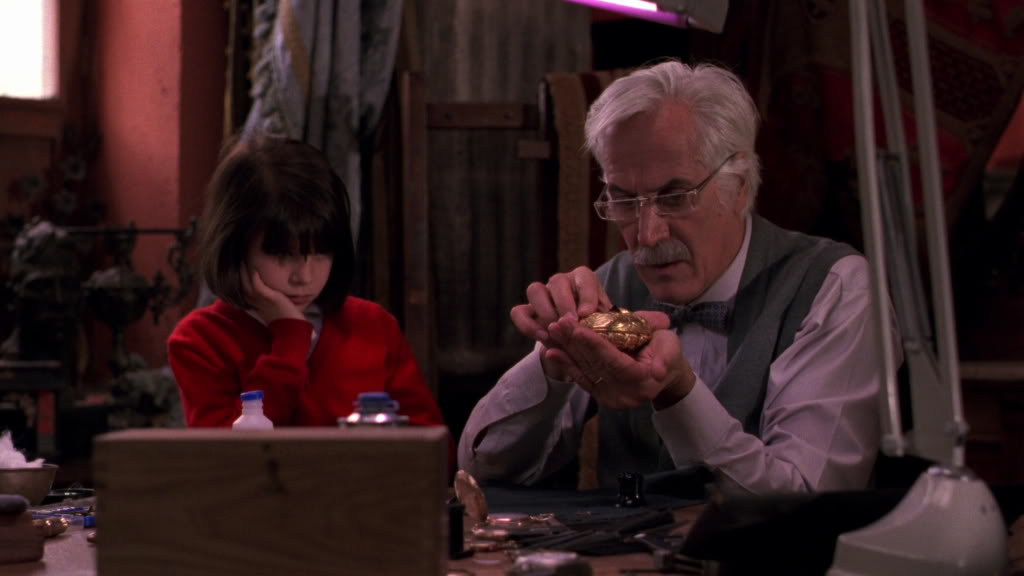
“There are two levels of vampirism: one is the regular vampire, which is just like it has always been; and then there’s the super vampires, which are a new breed we’ve created.”
-Guillermo del Toro
For his feature film debut Cronos, a then 29-year-old del Toro reimagines the traditional vampire tale as a failed quest for immortality, an ultimately pointless pursuit that results in both the physical and psychological decay of the human body.
Considered the modest first entry of an unofficial trilogy that has recently gained legitimacy with the Criterion Collection release Trilogía de Guillermo del Toro (also includes The Devil’s Backbone and Pan’s Labyrinth), Cronos serves as a foundation for the Mexican director’s defining traits – gothic imagery, elaborate production designs, religious iconography, humor as supplement to horror, and man-monster dichotomy – that he would expand throughout his career.
Rather than revealing the dynamics of vampirism through a high-conceptual plot, del Toro conveys it through character. During the first of what is currently three collaborations with the director, Spanish-Argentine Federico Luppi plays Jesus Grís (perhaps a nod to the Christian savior), an old antique dealer leading a seemingly tranquil and ordinary lifestyle along his wife Mercedes (Margarita Isabel) and taciturn granddaughter Aurora (a virtually mute newcomer Tamara Shanath), until he comes upon an ancient golden mechanical device resembling a scarab, which by accident stings Grís and grants him virility, youthfulness, and an overwhelming thirst for blood. Needless to say, the afflicted old man struggles to hold on to his humanity as he undergoes a physical transition towards undead monstrosity.
Opposite to Grís is the wealthy, but dying industrialist Dieter de la Guardia (Claudio Brooks), who obsessed with attaining immortality to enjoy his wealth, enlists the help of his American nephew, a vain goon by the name of Angel (a wisecracking Ron Pearlman), to personally chase after and seize the mysterious artifact under any means necessary. Otherwise risking the character to become a one-dimensional grunt in the hands of another actor, Pearlman succeeds in portraying Angel as both hilarious and endearing whilst being petty and cruel, and stands out as one of the likable odd-balls of del Toro’s filmography.
Despite Aurora’s character leaving much to be desired (in contrast to the portrayal of children in del Toro’s later films), as well as enduring through a somewhat tedious pace during the second half of the film – following the aftermath of Grís’ resurrection when the film dissolves to a straightforward face-off against the de la Guardia duo – Cronos overcomes its narrative mishaps through Luppi’s performance as the tragic hero, which coupled with del Toro’s pen, is able to convey both the emotional confusion and fanciful sense of self-discovery brought by his accursed condition.
The production design combines both Catholic iconography and gothic antiquity to create an articulate, highly detailed scenography, the lore inspiring antique shop and de la Guardia’s residence come to mind, the latter of which inhabits a line between a sci-fi dissecting lab and a plain morgue. However, the overall artistic design starts to crack during the second half of the film, particularly the undead/vampire make-up which, opposed to the meticulous texture and authenticity of the aforementioned designs, loses its flair and perhaps earns the film an unwarranted B-horror quality (this may be due to the budget conflicts del Toro faced during production).
Adding to its religious undercurrents to the afterlife, Cronos literalizes Shutter Island author Dennis Lehane’s quote, “which would be worse, to live as a monster or to die as a good man?” Although such a multi-layered story would have soared even higher with the experience and resources del Toro now has, Cronos succeeds in evoking the viewer to question what is the magnetic force between man and monstrosity? If life prepares us for the afterlife, is immortality a punishment? How does the former triumph over the latter? Is it love? Moral conviction? Self-sacrifice?
3. Hellboy II: The Golden Army (2008)
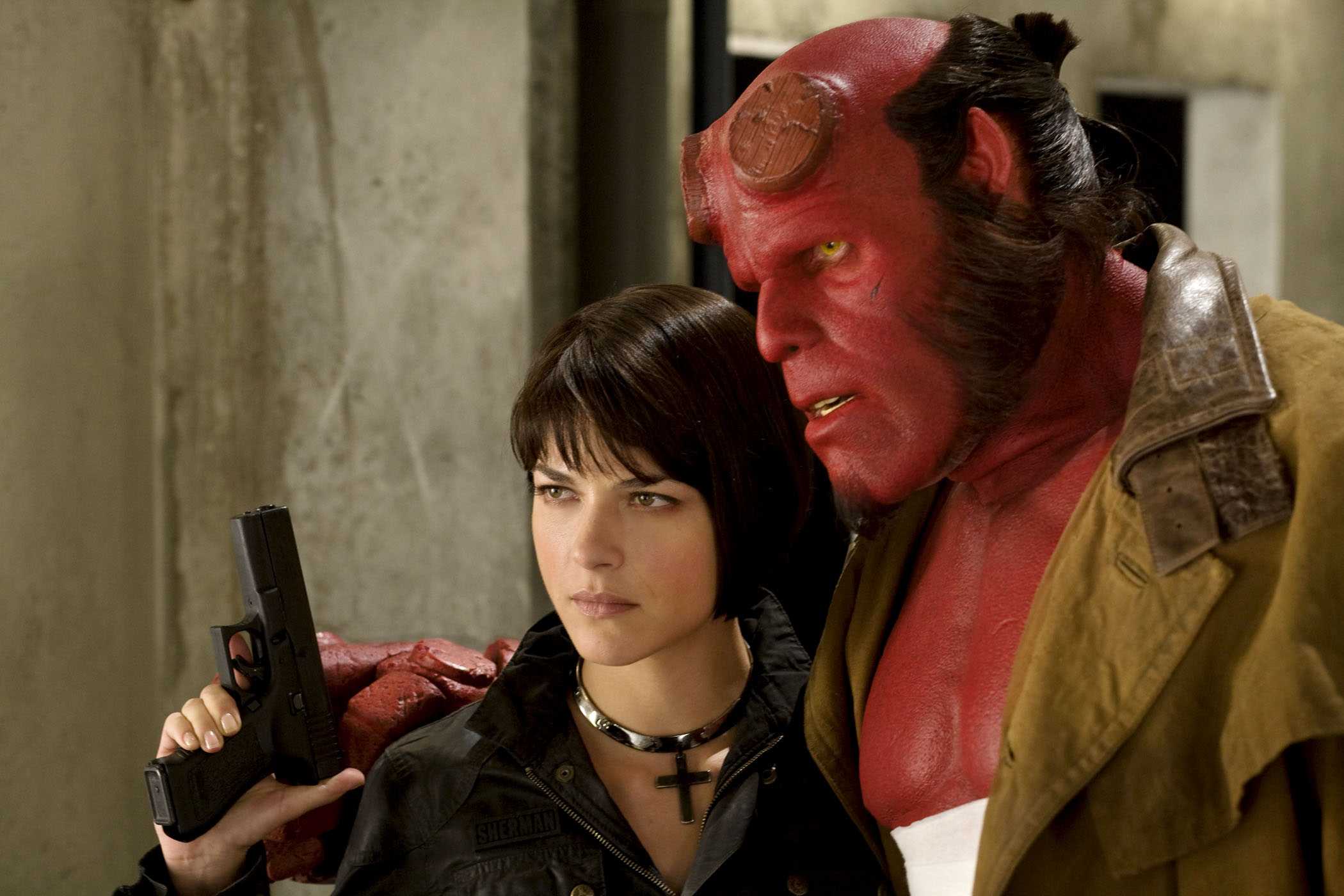
“I believe in man. I believe in mankind, as the worst and the best that has happened to this world.”
-Guillermo del Toro
Although the original Hellboy might have a more profound character driven story, The Golden Army deserves an edge over its predecessor for providing a thrill ride of visual ingenuity and deliberate, over-the-top humor, while retaining a fluid narrative pace. Expanding its gothic roots to the more visually dynamic dark fantasy realm, del Toro’s follow-up invests the big bucks on state-of-the-art technology in order to bring del Toro’s musings to life, a CGI dark fantasy extravaganza that includes: a swarm of calcium-devouring winged critters or “tooth fairies,” the usual showdown in the streets of Manhattan in the form of a giant tentacle plant, and the eponymous army comprised by a myriad of magmatic gear headed, mechanical soldiers.
The Golden Army begins with a prologue featuring John Hurt’s Dr. Broom reading to a young (and endearingly funny-looking) H.B. a tale about an ancient warfare between humans and mystic creatures (elves, trolls, monsters, that sort of thing) that preambles the events to follow.
In the present day, we get a snippet of Hellboy’s daily life (Ron Pearlman) – still a cigar-munching, wisecracking rebel – but leading a conjugal lifestyle with girlfriend and pyro-kinetic Liz (Selma Blair), who now sports short hair and is more on the temperamental side rather than an introvert. Additionally, series alumni aqualad Abe Sapien (Doug Jones buried in more make-up this time around) and the hysterical BPRD supervisor Tom Manning (Jeffrey Tambor) return.
Unfortunately, danger lurks at the horizon in the form of the strongly idealistic, silver haired Prince Nuada (Luke Goss), who plans to decimate the human race in order to restore his elven race back to its “rightful” place after centuries of living in obscurity, by seizing control of the all-powerful Golden Army.
In order to create perspective, if not sympathy for the prince’s radicalism, perhaps del Toro assimilates humankind to an institutionalized authority that should be overthrown in favor of a lower, oppressed class. Regardless of the case, the stakes feel lower this time around, the content is lighter and simpler, but not only does Pearlman’s charismatic performance as the neo-noir superhero remains a lighthearted marvel that justifies the tonal shift, but del Toro presents some of his most mind-boggling set designs.
For instance, the troll market scene, a secret flea market located under the Brooklyn Bridge, introduces the viewer to a macabre bacchanalia filled with some of the most bizarre (and absurd) supernatural creatures – dwarves, ogres, witches, Lovecraftian monsters, a deformed monster with a speaking-baby tumor, and more – which is not only astounding, but it casts the impression of an Easter-egg museum of the Mexican horror auteur, whose frames deserve to be paused and observed.
Also, del Toro’s inventive imagination extends from set designs to the action scenes themselves. The Golden Army showcases impressive climactic action sequences such as the showdown between Hellboy and the acrobatic, spear wielding Prince Nuada on top of interlocking gear grinds that cast the impression of a Hephaestan metallurgy, if not the inside machinations of the scarab device in Cronos, as well as more emotional turns such as the garden that flourishes from the giant tentacle plant’s corpse.
Lastly, del Toro’s visually rhapsodic follow-up to the more obscure 2004 superhero film, stands as his ideal blockbuster to date in that, similar to Pacific Rim and Crimson Peak respectively, uses its storyline as context for gratifying action setpieces and a visually staggering mythological tour guide that his previous films have been building towards. However, more along the lines of its predecessor, The Golden Army offers endearing, relatable characters that after nearly ten years, still leaves viewers with hope for a third installment.
2. The Devil’s Backbone (“El espinazo del diablo,” 2001)
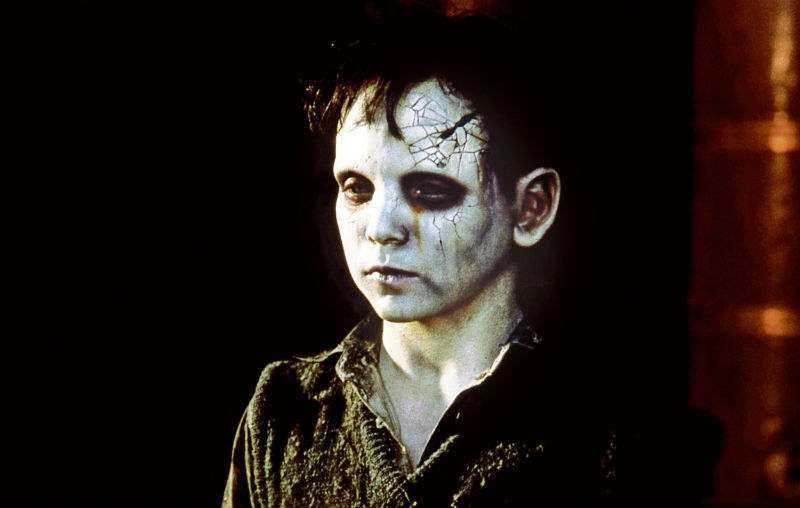
“What is a ghost? A tragedy condemned to repeat itself time and again? An instant of pain, perhaps. Something dead which still seems to be alive. An emotion suspended in time. Like a blurred photograph. Like an insect trapped in amber.”
-Federico Luppi’s Casares in The Devil’s Backbone
The impact a war-ravaged country has on the oversensitive imagination of a child oftentimes leaves psychological scars beyond repair, whereas the young lives tragically lost to its cruel, if not chaotic synergies are, as one character cleverly puts it, “the devil’s backbone, children who should never have been born.”
Del Toro’s atmospheric psychodrama transcends the physical monstrosities of his previous features – Cronos and Mimic – and, on similar ground to his co-produced film The Orphanage (“El Orfanato”), visualizes the traditional ghost tale not only as a sad, mournful story about regret, but also as a chain of events sprung by the echoes of a forlorn, traumatized young soul searching for answers, if not justice, for its unfair and early departure.
The Devil’s Backbone takes place in Spain during the last days of the Civil War, in a remote orphanage sheltering the children of Republican-loyalist families, ran by a late-middle aged duo: the poised and well-cultured Casares (Federico Luppias as an eloquent, “old country” man) and the one-legged headmistress Carmen (Marisa Paredes), who inherited the property after her husband, a leftist poet died.
Other staff members include an engaged couple: maid and teacher Conchita (Irene Visedo), and the ominous caretaker Jacinto (Eduardo Noriega as a self-righteous “prince without a kingdom”), who is a temperamental former student of the orphanage, as well as the living embodiment of the hatred sprung by his war-torn land.
When the protagonist, a well-meaning young boy by the name of Carlos (Fernando Tielve), arrives at the orphanage, he quickly becomes acquainted with the other orphans – striking a shaky friendship with the oppressive, yet afflicted Jaime (Íñigo Garcés) – but also becomes the target of “the one who sighs,” a sad, nebulous figure who seems to share a connection with a deep-water tank in the basement. After a few incidents, Carlos starts to investigate the truth behind the specter’s identity and plight, which will inevitably lead to unfortunate revelations.
For all its turns and subplots, del Toro’s anti-traditional ghost tale might be targeted for being one of his most predictable, but it matters little, since its told with remarkable authenticity through heavily emotional and gut-wrenching setpieces. For instance, Carlos’ nightly venture against school regulation in order to collect water in the kitchen might sound derivative on paper, but del Toro introduces different variables – objects mysteriously falling on their own, Jaime’s ill intentions, the threat of Jacinto’s arrival, and Carlos’ own curiosity about what lies in the basement – that keep adding to the tension of eminent danger towards a gratifying, dramatic payoff.
Along DP Guillermo Navarro’s grainy, shimmering yellow hues and consistent visual storytelling, del Toro’s self-proclaimed most personal film stands out as his most old-fashioned entry. Through an overarching control of both mood and tension, a departure from the orphanage setting in order to raise the stakes, such as the narrative threatens at one point, is never necessary, not even fathomed, since del Toro goes as far as subtly establishing a sense of direction in his self-contained atmosphere.
Sustained by its own mythos – del Toro’s combination of lore and history – like the malfunctioned nuke resting, nose-down on the courtyard, the on-display crucifix disguising the leftist orphanage as an ordinary Catholic school, and the ghost itself, speak of the details del Toro inserts to convey a scope of time. The perception of the ghost as an absent moment, a lost emotion, or fragment of a former self that history repeatedly insists us on remembering.
1. Pan’s Labyrinth (“El laberinto del fauno,” 2006)
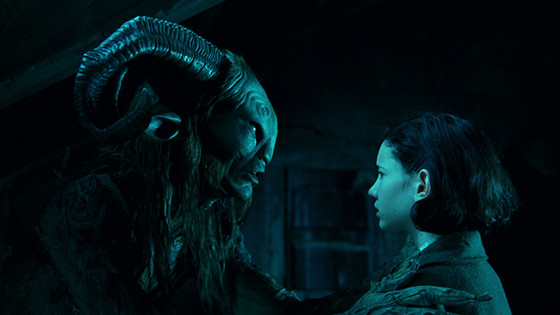
“Many, many years ago in a sad, faraway land, there was an enormous mountain made of rough, black stone. At sunset, on top of that mountain, a magic rose blossomed every night that made whoever plucked it immortal. But no one dared go near it because its thorns were full of poison. Men talked amongst themselves about their fear of death, and pain, but never about the promise of eternal life. And every day, the rose wilted, unable to bequeath its gift to anyone… forgotten and lost at the top of that cold, dark mountain, forever alone, until the end of time.”
-Ivana Baquero’s Ofelia in Pan’s Labyrinth
Fantasy and horror. An underground paradise of fable and a war-ravaged wasteland. Fauns, fairies, frogs and the sound of a bottle pounding a nose until it’s a bloody pulp crater. Many films showcase a juxtaposition between history and fiction, some better than others, but to seamlessly weave it together into a violent fantasia, or a magical realism reminiscent of Buñuel, attest as to why after a decade, Pan’s Labyrinth remains the apex of del Toro’s untapped creative ambition.
A spiritual successor to the horror auteur’s personal ghost tale The Devil’s Backbone, this sinister fairy tale re-introduces the tensions of political warfare in post-Civil War Spain (this time around between the Falangist fascists and the Spanish Maquis guerrilla), but instead of a confused young ghost suspended in time, it follows the 11-year-old girl Ofelia (Ivana Baquero), who shares an obsession for fairy tales and fantasy books, as well as an undisclosed ability to interact with mystical creatures only visible to her.
Accompanying her pregnant, but ill mother Carmen (an emotionally fragile Ariadna Gil), a reluctant Ofelia moves in to an old mill at the Spanish countryside – acting as a Falangist headquarters to hunt down remaining anti-Franco guerrilla groups – to accompany Carmen’s husband as well as Ofelia’s new stepfather Captain Vidal (Sergi López in a memorable role as the antagonist), an indelibly sadistic, calculative chauvinist who only values his wife for reproduction purposes, as well as seems to embody the ruthless, clockwork authoritarianism del Toro associates with evil.
By this point del Toro partitions the action between two equally immersive focal narratives: The war front, led by Vidal’s chief servant, but undercover anti-Francoist Mercedes (Maribel Verdú as a stand-in for the enduring revolutionary spirit), who holds secret meetings with accomplice Doctor Ferreiro (Alex Angulo) to discuss how to aid the Maquis soldiers overthrow Vidal.
The second, a perverse spin on the traditional fairy tale, features the iconic Faun (Doug Jones in his most eerie), an ominous goat-like humanoid resembling the Greek god Pan, but covered in moss and nature’s debris, who charms (or beguiles) a frightened Ofelia to overtake three challenges in order to restore her place as the immortal princess of an underground kingdom as prophesized by a familiar myth.
The three tasks take Ofelia to visually ornate landscapes and meet bizarre creatures that as Baquero’s reactions of disbelief and wonder go to show, are as real as the Falangist-Maquis bloodshed, while also feeling overridden with symbolism and multiple allegorical designs (a testament to the film’s high malleability of interpretation).
For instance, the imagery behind the Pale Man (also Doug Jones) – the sumptuous banquet, the eyeballs on the palm of its claws, and the skin hanging from its abhorrent body – suggest the urge to devour purity, or the lust for power at the price of morality and innocent lives, and perhaps represents the oppressive powers in Ofelia’s world such as Vidal, the Francoists, or religious order.
Recognized for its engrossing visual ingenuity, as evident by its Academy Award victories in cinematography, make-up, and art direction, del Toro improves the thematic and atmospheric balance of the 2001 Spanish film, by crafting an amalgamation of his self-defining traits: the parallels between mythology and reality, pure CGI animation as its own dialect for fairy tale narration, both multiple and memorable interpretations of evil, and incredibly detailed set designs such as the baroque labyrinth whose mossy-stone surface pitted against the abyssal shadows is visually resonant with the notion of forgotten fables and lost wonder.
Similar to the moral ambivalence the Faun inspires, whose thespian gestures aim to stimulate trustworthiness, but the words behind its glassy stare concocts doubt, Pan’s Labyrinth conjures history and fantasy, war and fairy tales as a wholesome, imperfect reality where violence and pain are permanent, yet hope and self-sacrifice are possible to achieve. As Ofelia’s tale illustrates, Pan’s Labyrinth is ultimately a parable about choices; a moral of attaining self-discovery through disobedience, which remains hidden away in the wormhole of fantasy and the grotesque that del Toro captures so effortlessly.